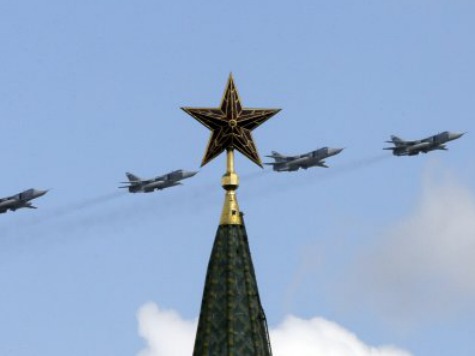NATO and the United States monitored more Russian jets in the Baltic region on Saturday and Sunday. Reports of Russian jets flying threateningly close to the Baltic states have become a near-weekly occurrence, yet NATO regularly issues concerns and warnings without taking action.
On Saturday, NATO’s F-16 jets intercepted six Russian bombers, which included the Tu-95 and Tu-22. The jets were again intercepted on Sunday. A US official told CNN it was the first time they witnessed a large convoy of planes in span of two days. The same official said “it’s a Putin show of force,” while Rear Admiral John Kirby described the flights as “significant.”
“The overflight is doing nothing to ease tensions,” he said. “But while it is bigger than what we’ve seen, it is not raising alarm bells in NATO.”
On November 9, Breitbart News reported that NATO intercepted over 100 Russian planes in 2014, which is three times more than 2013. Then, on November 21, CNN reported that NATO “scrambled fighter jets more than 400 times this year.”
“This pattern is risky and unjustified,” said NATO Secretary General Jens Stoltenberg. “So NATO remains vigilant. We are here. And we are ready to defend all allies against any threat. They are not filing their air flight plans. They are not turning on the transponders. And they are not communicating with the civilian air traffic control. We are calling on Russia to conduct their military air activities in a responsible way and respecting international norms for this kind of air activity.”
NATO was busy the last three days of October when they “tracked Russian military planes that included fighter jets, long-range bombers and tankers over the Baltic region, the North Sea and the Atlantic Ocean.” Jets deterred over nineteen Russian planes just on October 29. The majority of planes were located in the North Sea and Atlantic Ocean. Radar did show eight planes heading toward the Norwegian Sea, but six planes turned around after the Norwegian Air Force pushed back. Two planes, Tu-95 Bear H bombers, continued towards Norway until NATO planes in the United Kingdom tracked them and forced them back to Russia.
But it is not just in the air. Russia tests borders on water and land. Portugal, a member of the European Union and a founding member of NATO, chased a Russian ship out of their waters on November 6. Russia claims the ship conducted “marine research,” but Portugal intervened when the ship floated almost fourteen miles from the coast.
There has always been tension between Russia and NATO, the relationship has deteriorated since Ukraine’s parliament ousted Russian-backed President Viktor Yanukovych on February 22. Russia immediately stepped in to annex Crimea from Ukraine and help the pro-Russian militants in east Ukraine. Ukraine is not a member of NATO, but borders NATO nations Poland and Romania. On March 2, The North Atlantic Council, NATO’s key governing organization, condemned Russia’s “military escalation in Crimean and expresses its grave concern regarding the authorisation by the Russian Parliament on the territory of Ukraine.” They called on Russia “to de-escalate tensions.” Yet, despite Russia continuing to escalate tensions, NATO continues to not act. They warned Russia, again, on May 29.
In May, reporters claimed that Chechen Russians infiltrated parts of east Ukraine during the presidential elections. The men said their leader, Ramzan Kadyrov, sent them to Ukraine. Kadyrov, who is best friends with Putin, denies the charges. Russian Foreign Minister Sergei Lavrov admitted Moscow sends “humanitarian” aid to east Ukraine, but did not elaborate. Militant leader Igor Girkin said the aid includes military equipment. NATO even admitted more Russian troops crossed Ukraine’s border in November.
NATO’s inaction appears to peak in response to the attack on Malaysia Airlines MH17. In July, MH17 was shot out of the skies over eastern Ukraine, killing all 298 people on board. Evidence clearly implicates pro-Russian rebel forces fighting the Ukrainian government in the attack. NATO has yet to respond despite the fact that eighteen passengers belonged to NATO nations. The militants admitted they possessed a Buk missile system, which has the capability to shoot down a passenger plane, similar to the ones owned by Russia. Journalists spoke to residents who witnessed a Buk system through Snezhnoye on its way to Torez, where the plane was shot down. NATO released press releases and statements and held a minute of silence, but no action to punish Russia or the pro-Russian militants. New reports show that Russia did in fact give the militants the Buk missile system.
If the MH17 tragedy did not galvanize NATO into action to contain Russia, little can be expected of the international organization in the future.

COMMENTS
Please let us know if you're having issues with commenting.